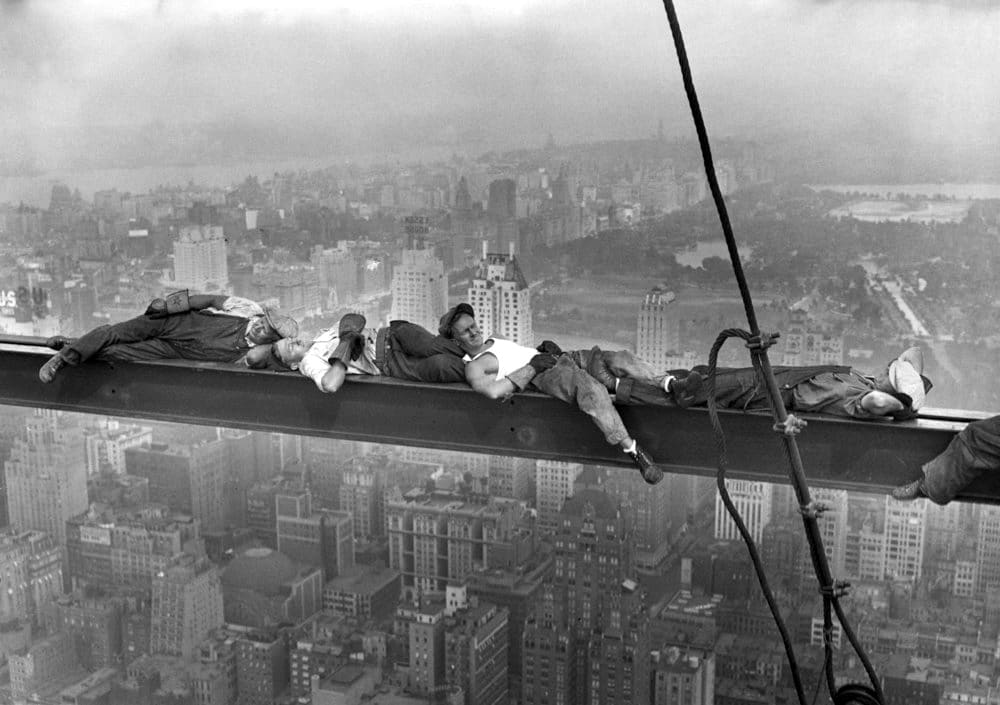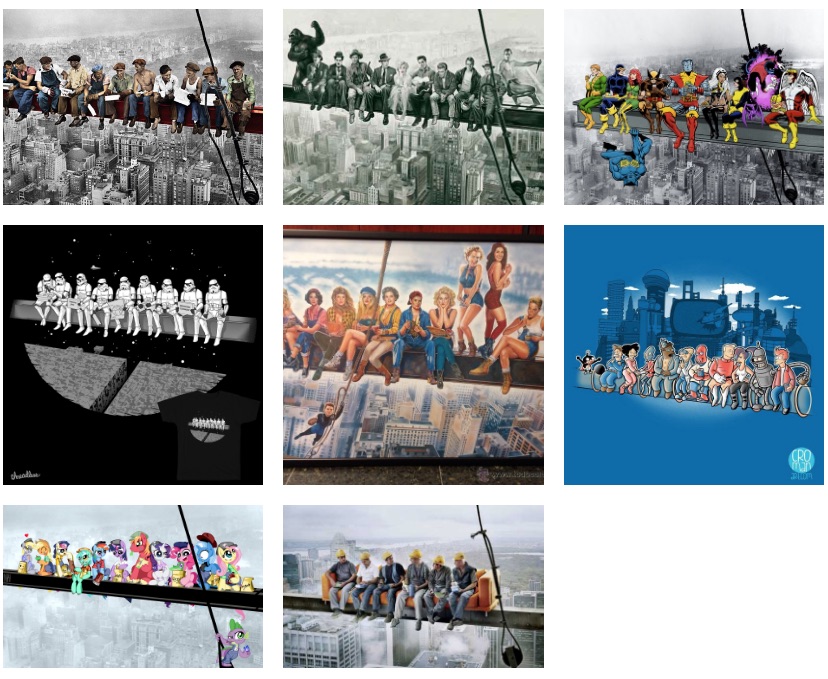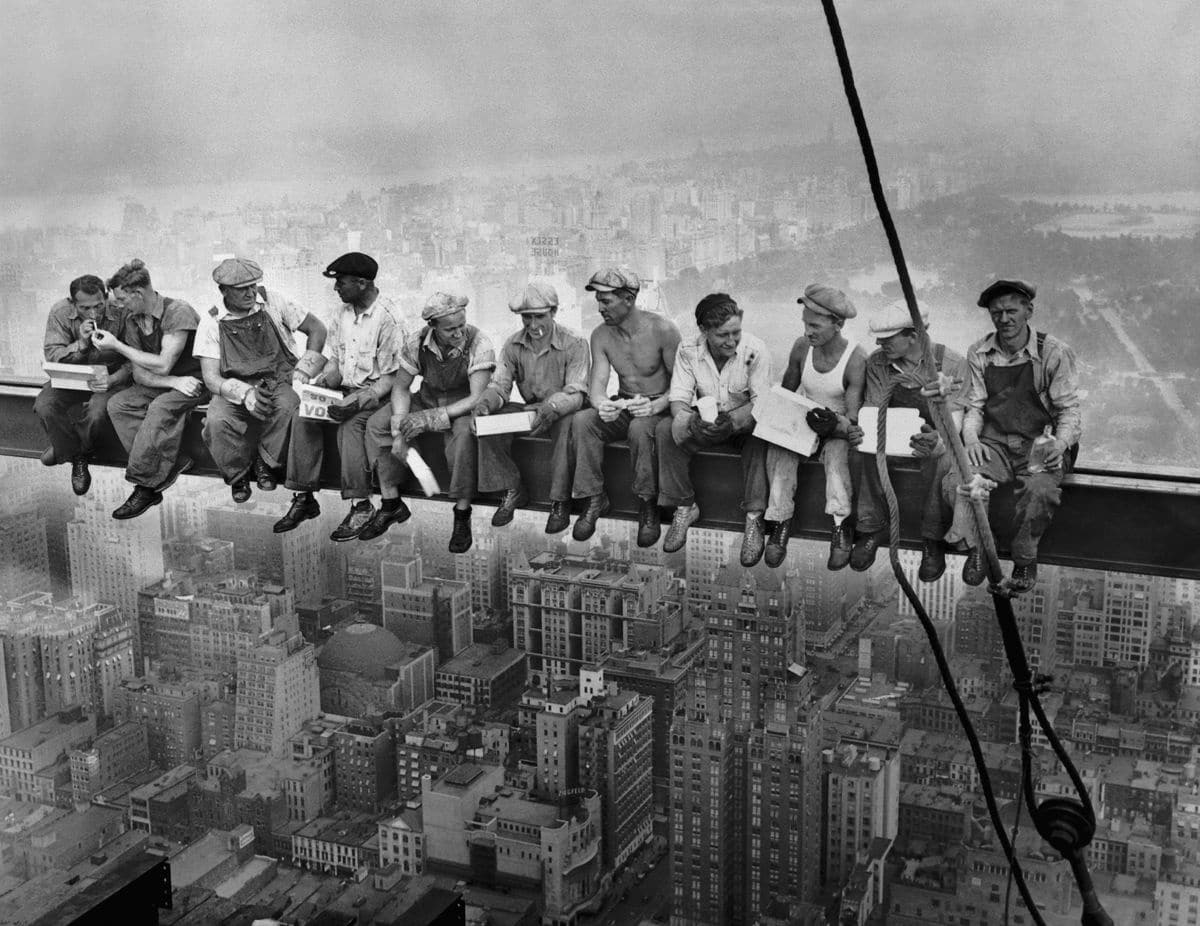Second part of “Lunch atop a Skyscraper”
In the first entry in this series, we saw the famous photo taken from the top of a New York skyscraper on September 20, 1932, titled Lunch atop a Skyscraper by photographer Charles C. Ebbets. In it, we can see eleven workers, most of them European immigrants, and some Native Americans, defying the heights (580 ft/260 m) while taking a break during a hard day’s work, with all the risks entailed by working without even the most basic safety measures.
Even so, it would seem the picture was not spontaneous, but was rather posed by the photographers who were reporting on and promoting Rockefeller Center while it was under construction. As we can see in the pictures below, in other photos taken on the same day, some of the workers seem to be throwing around a football, pretending to sleep on the steel beam, and waving with their hats.


Remakes and parodies of the famous photo.


Photographers and workers
In addition to the photographer, Charles C. Ebbets, two other professionals went to the top of Rockefeller Center at that time, William Lefwich and Thomas Kelley, who may be the ones in these pictures defying the immense danger posed by hauling up heavy camera equipment in such a precarious situation.
But all is not as it seems in the picture. Actually, one of the finished floors of the building was just a few feet below the workers on the beam. It was one of the many photos taken and shared with the media to promote real estate in the Great Depression, after the Bust of ‘29, though, as Rockefeller Center archivist Christine Roussel stated, “the photographers were absolutely crazy.”
For the photographers, the risks were only for a day or two, but for the workers building New York’s famous skyscrapers, it was their daily reality. Safely measures simply didn’t exist, and they had to overcome the vertigo of being 1000 ft or 300 m in the air, working under those conditions.
The presence of these men in the photograph is the synthesis of an era. After the Bust of ‘29, there was very little work, especially for immigrants, many of them Europeans who came to the New World in search of a new life the “Old World” couldn’t provide, torn as it was by continuous wars. As John Rasenberger, author of High Steel: The Daring Men who Built the Greatest Skyline in the World, said, “The pay was good. The thing was you had to be willing to die.”
Workers from Biscay atop the beam
A few days ago, we got a call from an author from Bilbao (who wished to remain nameless)., stating that ten years ago, some information had been gathered about some of the workers who appear on the beam as they were related to Biscay. As usually happens in these cases, the information reached us by a family member of one of those on the beam.
With this report, and another he put together himself, he contacted El Periódico in Bilbao, and also El Correo, but neither considered the article worthy of publication.
Since neither of the two papers wanted to report this news that had been so kindly presented to them, and worried that the news might be lost forever, the author contacted us to provide us with the dossier and corresponding photos.
Next week, we’ll uncover the mystery of the identity of this man from Biscay who almost surely is sitting on a beam at Rockefeller Center, as well as research the possibility that two more men from Biscay may be by his side.
Stay tuned to our publications, and, to make sure you don’t miss any, subscribe by clicking the button on the right, so you receive an email every day we publish a new article.
Harresi – /3/2021 – Euskadi
Los que construyeron los rascacielos de Nueva York
Veíamos en la primera parte de este artículo la famosa fotografía tomada en lo alto de un rascacielos de Nueva York el 20 de septiembre de 1932, titulada: «Lunch atop a Skyscraper«, del fotógrafo Charles C. Ebbets. En ella aparecen once trabajadores, la mayoría emigrantes europeos y algunos indios americanos, que desafían la enorme altura (260 metros sobre la calle) mientras descansan del duro trabajo y del riesgo que suponía realizar su labor sin las más mínimas medidas de seguridad.
(Follow) (Automatic Translation)
⇑List
Last Updated on Mar 19, 2021 by About Basque Country































